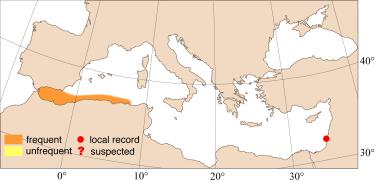|
SHORT
DESCRIPTION
Body slender. Snout moderately long, bluntly pointed to rounded. Anterior nasal flaps rather high, triangular and very broad. Eyes circular and relatively large. Mouth large and rounded. Usually 15/14 rows of teeth in each jaw half. Broad, high cusp and serrated teeth in upper jaw; high, narrow-cusped serrated teeth in lower jaw. A high and prominent interdorsal ridge. First dorsal falcate; its height much less than half predorsal space and its origin over or slightly before free rear tip of pectoral fin. Second dorsal fin origin slightly anterior to anal fin origin. Pectoral fins large, with narrowly rounded or pointed apex.
color :
dorsal blueish-grey, sometimes bronze-like; ventral whitish. Dusky fin tips (except for pelvic).
size :
50 - 200 cm (max. 288 cm).
|
|
DISTINGUISHING CHARACTERISTICS
Carcharhinus brevipinna, C. limbatus, C. melanopterus: inter-dorsal ridge absent.
Carcharhinus falciformis: the origin of first dorsal fin behind free rear tip of pectoral fin.
Carcharhinus plumbeus: anterior nasal flaps usually low and inconspicuous. First dorsal very high (height about half predorsal space) and interdorsal ridge low.
Carcharhinus obscurus: the ventral line of first dorsal fin origin closer to pectoral fin rear tip than to pectoral insertion.
Rhizoprionodon acutus: origin of second dorsal fin behind origin of anal fin.
Galeocerdo cuvieri: spiracle present, prominent lateral keels on caudal peduncle and coloration with vertical black or dusky bars on back.
Prionace glauca: papillose gillrakers present on gill arches, first dorsal fin midpoint equidistant or closer to pelvic fin origin than to axle of pectoral fin and coloration bright blue above, white below.
Squalidae: anal fin absent.
Lamnidae: caudal peduncle keeled laterally and caudal fin lunate.
Hexanchidae: dorsal fin single and six or seven pairs of gill-slits.
Triakidae: pre-caudal pits absent and upper edge of caudal fin with a straight margin.
BIOLOGY / ECOLOGY
Viviparous with an unknown gestation period, and up to 15 young per litter. Males and females reach maturity at 216 and 226 cm, respectively. In north eastern Atlantic waters, most young are born during August-September. Feeds on a wide variety of benthic species, mainly fish and cephalopods.
habitat :
bottom-dwelling species, usually found in deep-water over the continental shelf edge and upper slope (100 - 450 m depth). The young may occur in shallower waters.
|

